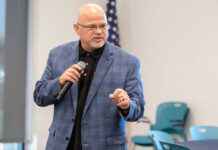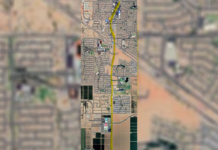
I don’t know about you, but I’m really ready to say adios to summer — well, at least goodbye to those daily temperatures in excess of 110 degrees — and welcome back cooler days and even cooler nights. It was a pretty good summer at first but the ending sure seems interminable.
Speaking of weather and climate, the University of Arizona’s Cooperative Extension Service is currently hosting a University of Arizona study as part of the National Climate Assessment which in turn generates a report to the president and U.S. Congress. I was recently invited to sit down with two of the researchers and eleven others from various economic sectors in the county to assess: 1) how federal agencies can provide climate-related information and programs to better meet the needs of rural Arizonans; 2) to assess the role that Cooperative Extension Service can play in this process.
It sounds dull and boring but it was interesting and thought-provoking. We all felt that better, more accurate and longer range forecasting would benefit virtually all of the economic activities in Pinal County. Of particular interest were the comments from Bill Thomas (Abbott Labs-Ross Products) about the impact of dust storms on their manufacturing processes. I’m looking forward to learning about their conclusions and whether our collective observations about current and past weather patterns match up to other parts of Arizona.
Last month I spent some time talking about the three “Game Changers” for Pinal County. Here are some more thoughts on one of those projects — Union Pacific Railroad’s Classification Yard proposal for the Red Rock area. The site they would like to acquire from the Arizona State Land Department (ASLD) is a little under 1,000 acres located east of I-10 and the main tracks of UP’s Sunset Line. As I said last month, Union Pacific has been working with ASLD staff since 2007 to acquire this site.
ASLD holds the land in trust for public education and is required see that any sales of those lands (through a public auction process) go for “highest and best uses” — presumably meaning residential rooftops. In light of today’s surplus supply of housing units, I personally think “highest and best use” means bringing jobs to Arizona so folks can afford to buy some of those empty houses.
In the midst of the hyper-growth of the last decade or in a “normal” economy that rooftop market goal probably made sense. But in today’s recessionary economy, we desperately need jobs, jobs, jobs to grow our way back to prosperity. So here we have a major employer with a sizeable budgeted sum of money to purchase land, a construction estimate for the project in the hundreds of millions of dollars, the very real prospect of a couple of hundred new Arizona jobs, and empirical evidence pointing to the ripple effect a yard like this has as a catalyst for transportation-related businesses.
Where do we go from here? You tell me. The challenge seems to be how to provide ASLD with enough information so they can see their way clear to letting the market speak by putting the land up for public auction as required by law.
Let’s move to your calendar for now. On Sept. 30, the Pinal-Gila Council for Senior Citizens, in conjunction with the Latino Familia Initiative and CAHRA (Central Arizona Human Resources Agency), is putting on a special event: Grandparents Raising Grandchildren Conference. Running from 9 a.m. to 2:30 p.m. in the Casa Grande Holiday Inn, this wonderfully useful workshop — open to grandparents in Pinal and Gila counties — will provide practical information and support resources to older adults caring for grandchildren. Experts and other professionals will be on hand to disseminate advice on child growth and development, guidance, and legal services. For more information or to register call Deb Goodman at 520-836-2758 or 800-293-9393, or Nikole Buckley at 520-723-1237.
By the way, have you seen the latest feature on the Pinal County website (http://pinalcountyaz.gov)? It’s an interactive Google map that shows the locations and status of various roadway construction projects that are either planned or underway as part of the Board-approved Transportation Improvement and Maintenance Program.
The details of each posted project or road closure can be viewed by clicking on the project icon on the map. When you bring up the County home page, chose Public Works Department from the All County Departments box, then choose Projects from the list on the left of the page, followed by clicking on the icon labeled Transportation Projects.
Finally, Pinal County property owners receive their 2011 Property Tax bills in the mail this month. Residents will notice right away the form looks different. The bills will arrive in a regular-sized envelope that will have the words “Real Property Tax Notice Enclosed.” Aside from changes in the size and colors, additional explanations about school district tax rates are moved to the reverse side of the form. The new bills have been printed and mailed out. County Treasurer Dodie Doolittle announced that property owners can also receive these Notices electronically by contacting her office at [email protected].
Did you know that Pinal County taxes (as enacted by the Board of Supervisors) make up only 25 to 30 percent of your tax bill? The remainder of your tax bill is made up of taxes assessed by school districts, Central Arizona College, fire districts and other special taxing districts.
Beginning in the 2008-09 fiscal year, the state balanced its budget by shifting the costs to provide state services onto county taxpayers.
In 2011-12, the legislature shifted more costs onto your local tax bill. The County-specific tax figure ($3.99) this year reflects $0.2369 per $100 assessed value that is the result of new program and cost shifts to Pinal County by the legislature. Some of those shifted costs and programs are the Arizona Department of Public Safety, the Motor Vehicle Division, salaries of judges, a mandated cash contribution to the state, treatment for sexually violent persons, and other costs that used to be paid by the state and are now shifted to counties.













![Carl’s Jr plans to “open soon” An exterior view of the new Carl's Jr. restaurant along John Wayne Parkway on May 7, 2024. [Elias Weiss]](https://www.inmaricopa.com/wp-content/uploads/2024/05/E1C66482-CB4C-4FD0-BA30-35CECE93F4BE-100x70.jpeg)

![Filiberto’s eyes building Maricopa restaurant An exterior view of a Filiberto's Mexican Food restaurant at an unknown location and date. [Jessica Boehm/Axios]](https://www.inmaricopa.com/wp-content/uploads/2024/05/axios-050724-filibertos-screenshot-e1715117410101-100x70.jpg)